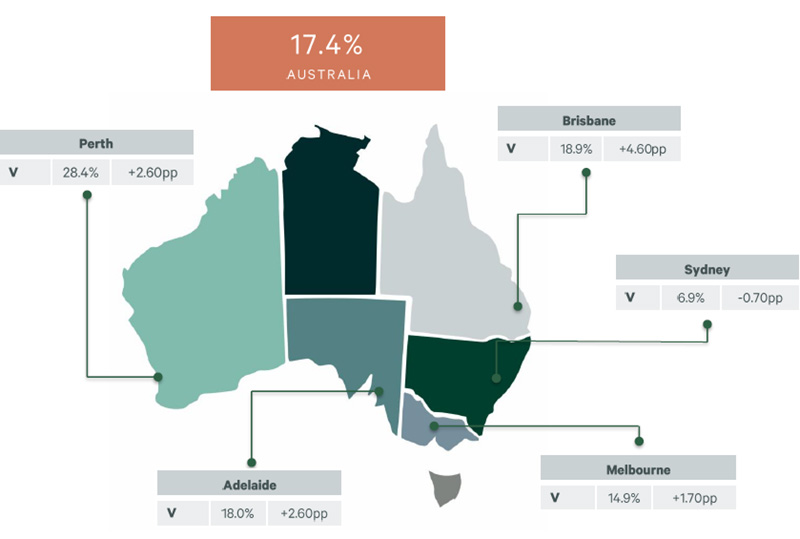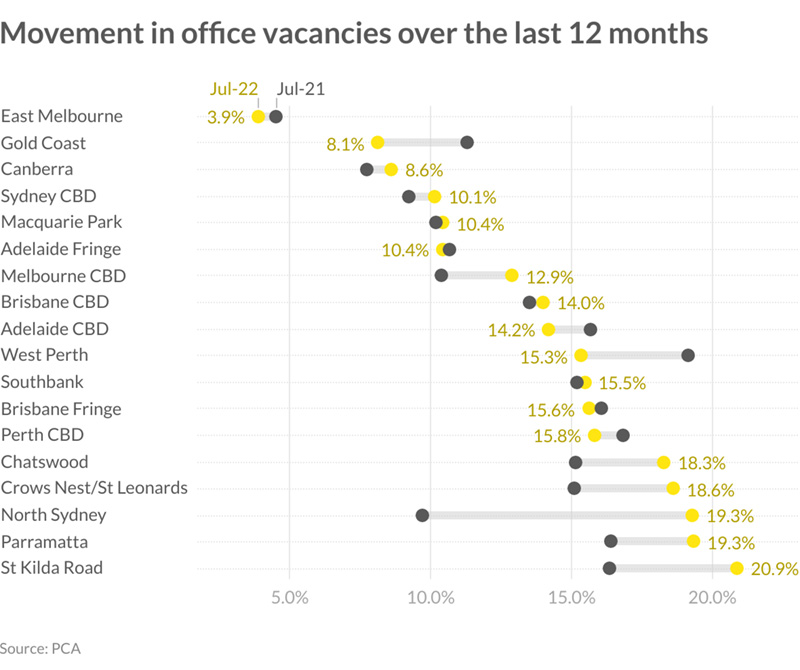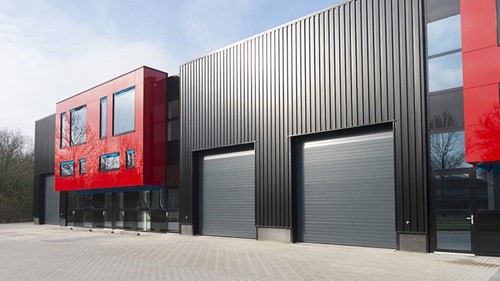Migration helping CBDs slowly emerge from the gloom
While dire predictions of the death of the CBD are not backed up by the numbers, the emergence of retail and office markets from the pandemic-era gloom is still proving to be a slow process.
Retail vacancies have continued to rise across Australia as offices struggle to fill desks and floors but signs have emerged that the post-pandemic urban exodus is beginning to correct itself.
Areas with strong migration and population growth, such as Perth, Brisbane, Gold Coast and parts of Sydney, have seen office occupancy improving.
The Sydney and Melbourne CBD office markets, however, have had mixed fortunes, with vacancy rates continuing to rise as new stock enters the market.
While the new stock may be a sign of confidence that prime retail and office space will eventually be in demand, its arrival has still put a dent in occupancy and vacancy rates.
Sydney is leading the national CBD retail recovery, with the city’s vacancy rate declining in the first half of the year as the return to the office gathers pace.
But across Australia, the CBD retail vacancy rate increased 3.5 per cent to 17.4 per cent in the first half of the year. Sydney recorded the lowest vacancy, followed by Melbourne (15.9 per cent), Adelaide (18.0 per cent), Brisbane (18.9 per cent) and Perth (28.4 per cent).
CBRE’s H1 CBRE Retail Vacancy Report shows that the Sydney CBD vacancy declined 70bps to 6.9 per cent in the first half of 2022, with the opportunistic expansion of premium and luxury retailers helping to drive demand.

CBRE’s Australia Head of Retail Leasing, Leif Olson, said there had been a slight increase in overall retail vacancy this half across Australia but demand was set to improve.
“As the return to the office gathers pace in the coming months, we expect to see more retailer mandates for prime mall locations across the country,” he said.
“The biggest improvements are being recorded for prime stock, with vacancy rates continuing to increase in secondary, non-core locations.”
With over 100,000sqm of new office stock entering the Sydney CBD market and only 21,692sqm of absorption for the six months to July 2022, vacancies have grown to 10.1 per cent. With gains in sublease space, these are expected to continue to increase as tenants continue to evolve their hybrid office models, according to Vanessa Rader, Head of Research, Ray White Commercial.
“With premium quality stock on offer and high incentives, the Sydney CBD has been instrumental in attracting tenants from some suburban markets, with vacancies having increased across the North Shore and collectively now representing 19 per cent, the highest recorded since 1993.
“Parramatta, however, has bucked this trend, still recording positive take up of 7,327sqm yet, with completions and supply still to be added to this market, and vacancies growing to 19.3 per cent as anticipated.”
Migrants make their call
Interstate migration has favoured Queensland and Western Australia and South Australia in recent times, which has flowed into the employment market and demand for commercial accommodation.
Brisbane CBD has enjoyed the greatest volume of office net absorption across the country at 44,690sqm for the six-month period, coupled with limited new supply additions reducing vacancies to 14 per cent after reaching 15.4 per cent in January 2022. Non-CBD markets remain in favour in these states with Brisbane Fringe enjoying 22,461sqm of take up, followed by the small Gold Coast market, which attracted 6,901sqm of demand.
Perth and Adelaide have had similar fortunes, West Perth an outstanding performer recording 11,449sqm of take up to reduce vacancy to 15.3 per cent after reaching 22.1 per cent just 18 months ago.
The Perth CBD has endured high supply yet has attracted 13,302sqm of demand. While vacancy remains elevated at 15.8 per cent, results remain encouraging for this market during a time where the development pipeline is heavy.
Adelaide, albeit a smaller market, has also benefited from 6,174sqm of absorption to reduce vacancies to 14.2 per cent, a three year low.

Retail shopping around
While the smaller office markets were outperforming the more populous large capitals, the retail scene was differentiating itself, at least in some sectors.
In Melbourne and Brisbane, clothing was hard-hit but high-end hospitality venues were in demand.
While the overall Adelaide CBD vacancy rose in Q1, Julia Pottenger, CBRE Associate Director, Retail Leasing, noted that Rundle Mall’s vacancy was the tightest it has been in almost 15 years at 4.1 per cent - the lowest in the country.
CBRE Senior Director and WA Head of Retail, Fred Clohessy, said a rebound in Perth’s office occupancy following the relaxing of COVID restrictions had brought some much-needed relief for CBD retailers.
“In June, Perth CBD office occupancy rebounded to 65 per cent - the second highest in the country - after dipping to 45 per cent in March 2022 when the state borders initially opened,” Mr Clohessy said.
“Total passenger volumes have more than tripled since the borders opened, with the retail market also positioned to benefit from the state’s extremely strong economic fundamentals and rising interstate migration driven by the state’s relative housing affordability and employment opportunities.”
CBRE’s Mr Olson noted that a return to the office in Sydney and the long-term value that retailers were identifying in high street flagships was helping to drive down the CBD vacancy rate.
Prime stock, which includes retail space on Martin Place, George, Pitt, King and Market Streets, is the most sought after with secondary locations suffering higher vacancies.
“Hospitality venues are performing well, with most quality restaurants performing above historic levels, but have had problems with staffing as well as balancing workers’ return to the city,” Mr Olson said.
“We’ve also seen strong demand from luxury brands, as well as footwear groups, looking to secure long-term leases for flagship stores in the city.”
Life in CBDs yet
Property Council NSW Executive Director, Luke Achterstraat, said that for more than two years there has been talk of how the ‘CBD is dead’ and dire predictions for the future of the office.
“Yet despite what the pundits may tell us, the market is detailing the exact opposite.
“Our latest bi-annual Office Market Report has shown a flight to quality in premium Sydney office space, maintaining and even strengthening our CBD.
“The increase to 10.1 per cent vacancy after remaining at 9.3 per cent for 12 months was due to an increase in supply in the past six months, even with hostile challenges from floods, industrial action, COVID, work from home advice and inflation.
“Whether each office requires one, three or five days with colleagues, the demand is strong for face-to-face interaction, with Sydney witnessing a two per cent rise additional office supply,” he said.




















